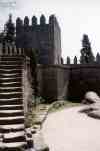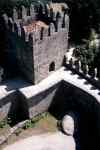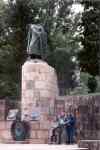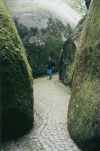|
|
|
In the 10th century, soon after it was founded by the Countess Mumadona, Guimarães consisted of a monastery with a defensive tower and a few neighboring houses. In the Middle Ages and later, new quarters were added to the south.
|
|
|
Nowadays, Guimarães is a prosperous commercial city with cotton and linen spinning and weaving mills, cutlery, tanning, and kitchenware industries. Equally successful are craft industries such as gold and silversmithing, pottery, embroidery, the weaving of linen damask and the carving of wooden yokes.
|
|
|
Guimarães is the cradle of Portuguese history. In 1095 Alfonso VI, King of León and Castile, bestowed the County of Portucale on his son in law, Henry of Burgundy (in France). Henry had the tower at Guimarães converted into a castle and installed his wife, Princess Teresa, there. In about 1110 Teresa bore Henry as son, Afonso Henriques, who succeeded his father in 1112. The young prince revolted against his mother, who acted as regent. In 1128 he seized power following the Battle of São Mamede. Next he campaigned against the Moors and succeeded in vanquishing them at Ourique on July 25, 1139. In the course of the campaign Afonso was proclaimed King of Portugal by his troops, a choice confirmed by the Count of Lamego and his cousin Alfonso, King of Leon and Castile in the Treaty of Zamora in 1143. This the recognized date for the birth of Portugal.
|
|
|
Source, Michelin Tourist Guide Book
|
|

|
The chapel in Guimaraes was constructed by the church using the standard floor plan. The Sacrament room was located on this side of this picture. A soccer court is located on the far side of the chapel. The lot is well landscaped and is located at the base of the hill located on the eastern edge of the city.
|
|
|
This is the view of the steps leading to the walls of the Castle. The main entrance to the castle, just out of view, is to the left of these steps. On the right you can see the court yard of the castle that surrounds the tower. The court yard was not very large nor very smooth. The entire castle is build on a large, granite rock.
|

Click to enlarge |
|

Click to enlarge |
Only a few walls are still standing for the living quarters in the castle. The opening for the windows for the various levels are clearly visible. Less visible are the fireplaces and mantle that appear to be hanging on the stone walls.
|
|
|
This is a view of one of the seven castle towers as they appear from the top of the castle keep or main tower. In the 10th century Countess Mumadona had the 92 foot keep built to protect the monastery and small town in its midst. The Castle was later built under Henry of Burgundy and reinforced in the 15th century. For the ramparts there is a wide view over Guimarães.
|

Click to Enlarge |
|

Click to Enlarge |
You can see the bridge leading from the castle walls to the Castle keep. The door, 20 feet up, is the only entrance into the castle keep and can only be reached over the bridge. Notice that the bridge is a wooden structure. This architectural feature makes the keep easy to defend from above.
|
|
|
From the castle the roof and chimneys of the Paço dos Duques are clearly visible. The palace was built in the early 15th century by the first Duke of Bragança, Afonso I, natural son of King Don João I. The Palace was one of the most sumptuous dwellings in the Iberian Penisula until the 16th century.
|

Click to Enlarge |
|

Click to Enlarge |
The palace was thoroughly restored to its original appearance in 1933. The palace consists of four buildings with massive corner towers, surrounding a courtyard. The vast rooms were heated with huge fireplaces. The rooms contain many large tapestries from the 16th and 18th centuries.
|
|
|
Down the hill and located in the praça in front of the castle and palace is the famous statue of the first king of Portugal, Don Afonso Henriques. The bronze statue was created in the late 19th century. This statue and the Castle are strong symbols of patriotism for the Portuguese. Former missionaries should notice a similarity between this picture and the sticker used for the qualification program. This picture was used to create that Sticker. However, you might notice he is facing the other way on the sticker. Oops.
|

Click to Enlarge |
|

Click to enlarge |
Down the street from the Chapel is one of the pretty fountains and pracas that make Portugal so pretty. The fountain decorated the roundabout. The gardens in the background have flowers that are changed with the seasons and the colors associated with the current religious holiday.
|
|
|
To the southeast of Guimarães is a forested rise. At the top is a fascinating park created among enormous boulders. Cobble stoned path ways run between, under, and over these gigantic granite rocks. Even on a hot summer day, the forest maintains a pleasant, cold temperature. Even adults feel like children. There is an irristable urge to run and hide among the nooks and grannys.
|

Click to enlarge |
|

Click to enlarge |
The granite boulders are covered with moss. The cobble stone paths wonder through the forest and rocks.
|
|
|
The West family enjoyed traveling to Guimarães often. President West enjoyed the historical part. However, the West children loved the McDonald's at GuimarãesShopping. There were especially delighted with the way the fast food restaurant was advertized. This car was one of a kind.
|

Click to enlarge |
|

